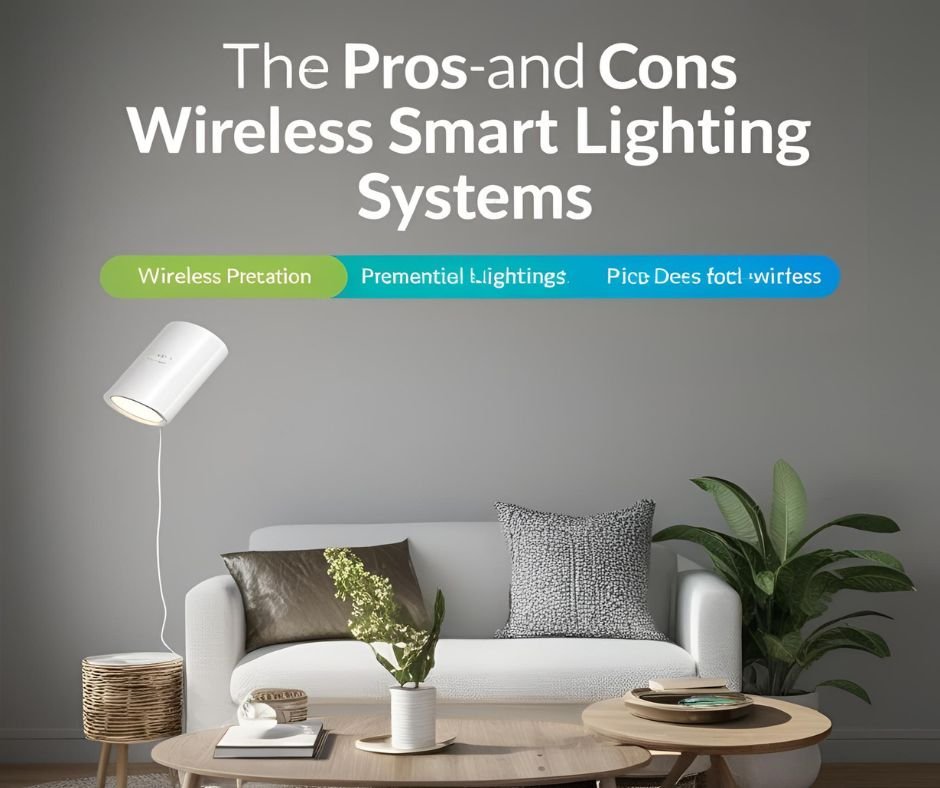
Thinking about upgrading your home with wireless smart lighting? You’re not alone. Wireless smart lighting systems are becoming more popular among homeowners and smart home beginners alike. These systems promise convenience, energy efficiency, and enhanced control over your lighting setup, all while requiring minimal installation effort. But are they the right fit for your home, lifestyle, and budget? Let’s explore the pros and cons of wireless smart lighting to help you make a well-informed decision.
What Is a Wireless Smart Lighting System?
A wireless smart lighting system allows you to control your home’s lights remotely through Wi-Fi, Bluetooth, or other wireless protocols like Zigbee or Z-Wave. Unlike traditional lighting setups, these systems don’t require complex wiring or switches. Instead, they rely on smart bulbs or modules that communicate with your smartphone, tablet, or voice assistant device.
Here’s a quick breakdown of how it typically works:
- Wi-Fi Lighting Control: Connects your smart bulbs or lighting hub to your home’s Wi-Fi network, enabling app-based or voice control from anywhere with an internet connection.
- Bluetooth Smart Bulbs: Pairs directly with your smartphone or tablet without requiring a hub, but the control range is limited.
- Zigbee or Z-Wave Protocols: These create a dedicated network for your smart home devices, offering a more reliable connection and better range for larger homes.
Now that you know the basics, let’s examine the benefits and drawbacks of wireless lighting automation.
Pros of Wireless Smart Lighting Systems
1. Easy to Install and Expand
Unlike wired systems, wireless smart lighting doesn’t require professional installation. You simply screw in smart bulbs, plug in lamps, or connect light strips to a power source. When it’s time to expand your smart home, adding more devices is just as straightforward.
2. No Rewiring Required
One of the most significant smart lighting benefits is that there’s no need to mess with electrical wiring. This makes wireless systems especially appealing for renters or anyone looking to avoid costly renovations.
3. Remote Control from Apps and Voice Assistants
With wireless technologies like Wi-Fi lighting control, you can manage your smart lights remotely via apps on your phone or through voice commands using Alexa, Google Assistant, or Siri. Forgot to turn off the lights on your way out? No problem, just tap a button or use a voice command.
4. Great for Renters and Small Homes
Since Bluetooth smart bulbs and Wi-Fi-based systems require minimal hardware, they’re perfect for renters or owners of smaller homes where a central hub might not be necessary.
5. Energy-Saving Features
Many wireless smart lighting solutions come with features like schedules, dimming, or motion sensors. These can help you cut down on energy usage, saving you money on electricity bills over time.
Cons of Wireless Smart Lighting Systems
1. Dependent on Internet or Bluetooth Connection
The major downside to wireless systems is their dependency on connectivity. Wi-Fi lighting control can falter if your internet goes down, and Bluetooth smart bulbs only work within a limited range (typically up to 30 feet).
2. Limited Range in Larger Homes
For larger homes, connectivity can become a significant issue. Signals may struggle to reach far-off rooms, especially if your home has thick walls or interference from other devices. Zigbee or Z-Wave setups can mitigate this, but they often require a central hub.
3. May Require Multiple Apps or Devices
Depending on the brands and protocols you choose, you may end up juggling multiple apps to control different lights. This can complicate your daily experience instead of simplifying it.
4. Potential Security Concerns
Wireless lighting systems operate on networks, which can be vulnerable to hacking. Ensuring that your system has strong encryption and regularly updated firmware is essential to protect your data and privacy.
Wired vs. Wireless Smart Lighting
Here’s a quick side-by-side comparison of wired and wireless smart lighting systems:
| Feature | Wired Systems | Wireless Systems |
|---|---|---|
| Installation | Requires professional installation | DIY-friendly |
| Control | Often requires physical controls | App and voice assistant-enabled |
| Connectivity | Unaffected by internet issues | Dependent on internet or Bluetooth |
| Flexibility | Difficult to modify once installed | Easy to expand or adjust setups |
| Cost | High initial installation cost | More affordable upfront |
Who Should Choose Wireless Smart Lighting?
Wireless smart lighting isn’t a one-size-fits-all solution. Here are some scenarios where it makes the most sense:
- Renters who can’t make permanent changes to their homes.
- Small homeowners who don’t need extensive setups or long-range connectivity.
- Tech-savvy users looking for convenient, controllable lighting systems.
- Budget-conscious homeowners who prefer an affordable and flexible entry into smart home automation.
If you have a larger home with connectivity concerns or require a highly reliable, always-on system, a hybrid approach with wired and wireless options might be worth considering.
Final Thoughts
Wireless smart lighting systems offer an enticing balance of convenience, flexibility, and smart lighting benefits. They’re easy to install, integrate well with modern smart home lighting systems, and are perfect for renters or smaller spaces. However, they’re not without their limitations, such as connectivity issues and potential security risks.
Before making the leap, evaluate your home’s size, your budget, and your tech requirements. If you decide this is the right path for you, wireless light automation can make your life easier and your home smarter.
Click here to discover everything you need to know about smart light sensors and how they can transform your space into a more energy-efficient home!
FAQs
Do wireless smart lighting systems require Wi-Fi?
Not always. While many systems use Wi-Fi for control, Bluetooth smart bulbs and Zigbee/Z-Wave setups don’t rely on internet connections, though their features may be more limited.
Are wireless lighting systems secure?
Yes, but they can be vulnerable without proper precautions. Always use systems with strong encryption, update firmware regularly, and secure your home network with a strong password.
Can I mix wired and wireless smart lighting in one home?
Absolutely! Many homeowners use a hybrid approach, leveraging the stability of wired systems in key areas while adding wireless features for flexibility and convenience in others.
